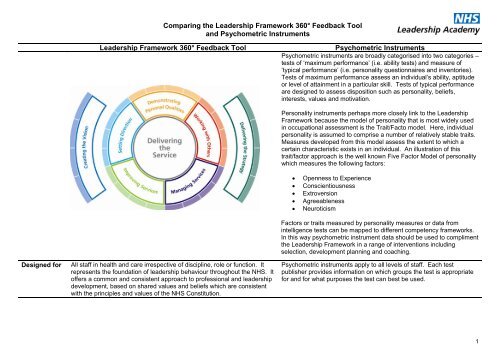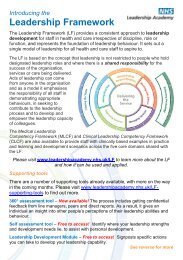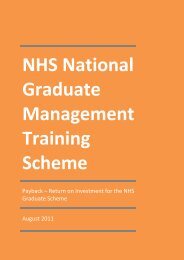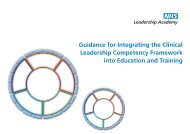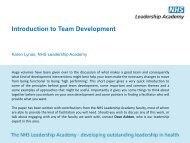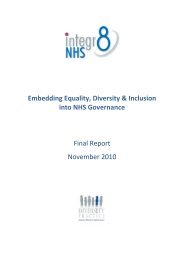Comparing the LF 360 Feedback Tool and Psychometric Instruments
Comparing the LF 360 Feedback Tool and Psychometric Instruments
Comparing the LF 360 Feedback Tool and Psychometric Instruments
You also want an ePaper? Increase the reach of your titles
YUMPU automatically turns print PDFs into web optimized ePapers that Google loves.
<strong>Comparing</strong> <strong>the</strong> Leadership Framework <strong>360</strong>° <strong>Feedback</strong> <strong>Tool</strong><strong>and</strong> <strong>Psychometric</strong> <strong>Instruments</strong>Leadership Framework <strong>360</strong>° <strong>Feedback</strong> <strong>Tool</strong><strong>Psychometric</strong> <strong>Instruments</strong><strong>Psychometric</strong> instruments are broadly categorised into two categories –tests of ‘maximum performance’ (i.e. ability tests) <strong>and</strong> measure of‘typical performance’ (i.e. personality questionnaires <strong>and</strong> inventories).Tests of maximum performance assess an individual’s ability, aptitudeor level of attainment in a particular skill. Tests of typical performanceare designed to assess disposition such as personality, beliefs,interests, values <strong>and</strong> motivation.Personality instruments perhaps more closely link to <strong>the</strong> LeadershipFramework because <strong>the</strong> model of personality that is most widely usedin occupational assessment is <strong>the</strong> Trait/Facto model. Here, individualpersonality is assumed to comprise a number of relatively stable traits.Measures developed from this model assess <strong>the</strong> extent to which acertain characteristic exists in an individual. An illustration of thistrait/factor approach is <strong>the</strong> well known Five Factor Model of personalitywhich measures <strong>the</strong> following factors:Openness to ExperienceConscientiousnessExtroversionAgreeablenessNeuroticismDesigned forAll staff in health <strong>and</strong> care irrespective of discipline, role or function. Itrepresents <strong>the</strong> foundation of leadership behaviour throughout <strong>the</strong> NHS. Itoffers a common <strong>and</strong> consistent approach to professional <strong>and</strong> leadershipdevelopment, based on shared values <strong>and</strong> beliefs which are consistentwith <strong>the</strong> principles <strong>and</strong> values of <strong>the</strong> NHS Constitution.Factors or traits measured by personality measures or data fromintelligence tests can be mapped to different competency frameworks.In this way psychometric instrument data should be used to compliment<strong>the</strong> Leadership Framework in a range of interventions includingselection, development planning <strong>and</strong> coaching.<strong>Psychometric</strong> instruments apply to all levels of staff. Each testpublisher provides information on which groups <strong>the</strong> test is appropriatefor <strong>and</strong> for what purposes <strong>the</strong> test can best be used.1
DescriptionThe Leadership Framework is based on <strong>the</strong> concept that leadership is notrestricted to people who hold designated leadership roles <strong>and</strong> where<strong>the</strong>re is a shared responsibility for <strong>the</strong> success of <strong>the</strong> organisation,services or care being delivered. The Leadership Framework has fivecore domains (Demonstrating Personal Qualities, Working with O<strong>the</strong>rs,Managing Services, Improving Services, <strong>and</strong> Setting Direction) <strong>and</strong> twoadditional domains (Creating <strong>the</strong> Vision <strong>and</strong> Delivering <strong>the</strong> Strategy)that relate to people who hold designated senior positional roles, <strong>and</strong> arerequired to act as leaders in formal hierarchical positions.Within each of <strong>the</strong> seven domains <strong>the</strong>re are four categories calledelements <strong>and</strong> each of <strong>the</strong>se elements is fur<strong>the</strong>r divided into fourdescriptors. Descriptors are <strong>the</strong> statements that describe <strong>the</strong> leadershipbehaviours, knowledge, skills or attitudes expected for each element.The application <strong>and</strong> opportunity to demonstrate leadership will differ, <strong>and</strong><strong>the</strong> context in which competence can be achieved will become morecomplex <strong>and</strong> dem<strong>and</strong>ing with career progression. The leadership contextis outlined in four stages <strong>and</strong> a suite of contextual indicators illustrate<strong>the</strong> type of activity staff could be demonstrating at each element <strong>and</strong>stage.The <strong>LF</strong> <strong>360</strong>° feedback questionnaire provides information on an individualfrom a number of sources <strong>and</strong> may be referred to as ‘multi-raterfeedback,’ ‘multisource feedback’ or ‘multisource assessment.’ The <strong>LF</strong><strong>360</strong>° feedback instrument is used to ga<strong>the</strong>r ratings <strong>and</strong> data specificallyon <strong>the</strong> Leadership Framework. <strong>Feedback</strong> is provided by direct reports,peers, line-manager <strong>and</strong> o<strong>the</strong>rs (e.g. customers if appropriate) on anindividual participant. The participant completes a self-assessment of<strong>the</strong>ir own performance against <strong>the</strong> <strong>LF</strong>. The <strong>LF</strong> <strong>360</strong>° feedbackquestionnaire consists of a number of statements rated on a five pointevaluative rating scale <strong>and</strong> includes <strong>the</strong> opportunity for each of <strong>the</strong> ratergroups to add free text comments on <strong>the</strong>ir perceptions of <strong>the</strong> participant.A report is generated on <strong>the</strong> participant providing useful data on how <strong>the</strong>yare perceived by o<strong>the</strong>rs. Apart from Line Manager’s feedback all o<strong>the</strong>rdata provided is non attributable. The <strong>LF</strong> <strong>360</strong>° report is fed back toindividuals by an accredited <strong>LF</strong> <strong>Feedback</strong> Facilitator.The results of <strong>the</strong> <strong>360</strong>° feedback are typically used by <strong>the</strong> participant in apurely developmental setting where <strong>the</strong> perspectives of multiple peopleare deemed to be particularly valuable. The <strong>LF</strong> <strong>360</strong>° rating scale is usedto obtain perceptions from o<strong>the</strong>rs as to how competently an individualdisplays leadership behaviours.Unlike <strong>360</strong>° feedback instruments, psychometric instruments provideinformation on an individual from only one source – <strong>the</strong> individual<strong>the</strong>mselves. Response forms, rating scales <strong>and</strong> <strong>the</strong> length of <strong>the</strong>questionnaire will vary by test publisher. <strong>Psychometric</strong> tests need toadhere to rigorous design principles to make sure <strong>the</strong>y are fair, ethicalas well as valid <strong>and</strong> reliable for selection purposes. Report formats canvary considerably but free text comments are not usually included.<strong>Psychometric</strong> instruments can be used both for selection <strong>and</strong>development purposes. More information on <strong>the</strong> similarities <strong>and</strong>differences between <strong>360</strong>° feedback instruments <strong>and</strong> psychometricinstruments is provided in <strong>the</strong> table below:<strong>LF</strong> <strong>360</strong>° feedbackMulti-rater instrumentLinked closely to <strong>LF</strong>competencesReport includes free textcommentsLess rigorous design principlesrequiredOption to include norm groups(when developed)Used for developmentpurposes only<strong>Psychometric</strong> instrumentsSingle rater instrumentLinked to various genericfactors <strong>and</strong> traitsReport usually excludes freetext commentsRigorous design principlesfocusing on reliability <strong>and</strong>validity dataOption to include norm groupsUsed for selection <strong>and</strong>development purposes2
ApplicationsDiagnostic<strong>Tool</strong>sMoreinformationApplications include:• Raising awareness that effective leadership is needed across <strong>the</strong>whole organisation• Underpinning a talent management strategy• As part of an existing leadership development programme• As part of strategic organisational development programme• Informing <strong>the</strong> design <strong>and</strong> commissioning of training <strong>and</strong>development programmes• Developing individual leadership skills• As part of team development• Enhancing existing appraisal systems• Informing an organisation’s recruitment <strong>and</strong> retention process<strong>LF</strong> <strong>360</strong> Degree <strong>Feedback</strong> <strong>Tool</strong>:www.leadershipacademy.nhs.uk/lf-<strong>360</strong>Self assessment tools:www.leadershipacademy.nhs.uk/self-assessment-toolswww.leadershipacademy.nhs.uk/lfApplications include:• Recruitment <strong>and</strong> selection of new staff• Identification of staff with <strong>the</strong> potential to be promoted• Counselling staff who are underperforming• Coaching session to maximise staff performance• Putting teams toge<strong>the</strong>r <strong>and</strong> enhancing team functioning• Establishing career interests <strong>and</strong> future career direction• Insight into emotional intelligence <strong>and</strong> development issues• Any decisions about people individually or people in groups<strong>Psychometric</strong> instruments are available through variouspsychometric test publishers. Visit individual test publishers’websites for fur<strong>the</strong>r information.www.psychtesting.org.ukwww.bps.org.uk3


